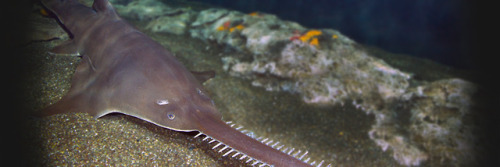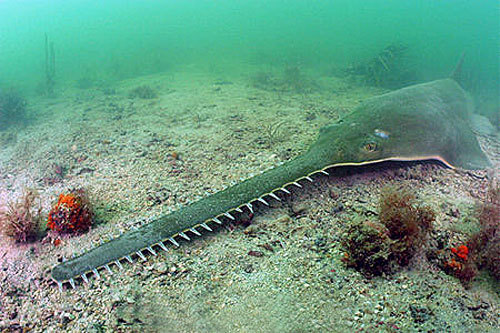#sawfish
Sawfish were once very common in their range, but are now amongst the most threatened marine fish. Although they are technically rays, not sharks, sawfish fins are prized for sharkfin soup, and sawfish parts are often used in Chinese, African, South American, Mexican, and Indian traditional medicine. They are also popular game fish, and their saws and teeth command high prices as souvenirs and trophies. Because of this frequent overfishing and rising pollution rates, most species of sawfish are now critically endangered.
Post link
There has been much speculation as to the purpose of the sawfish’s saw. Speculation was that they were used to literally saw chunks of meat from large prey such as whales or dolphins. In fact, the saw is lined with thousands of sensory organs that allow the sawfish to detect the electric fields emitted by living creatures, thus helping them track prey. Once a fish is detected, the sawfish will strike the prey with a sideways slash of the saw, stunning it, or else use the saw to pin it to the sea floor. While the saw is not used specifically to cut prey, a fish may be sliced in half by a particularly vigorous swipe. The saw is also used to defend the sawfish against large predators such as sharks, or in battles with rivals.
In contrast to stories of sawfish cutting through the bottom of boats or sawing humans in half, sawfish are known to be docile and harmless animals when left undisturbed.
Post link
Thegreen sawfish, also known as the longcomb sawfish or narrowsnout sawfish, is quite possibly the largest species of sawfish, historically reaching lengths of up to 24 feet. It was once found in 37 separate countries, but now populations have been confirmed in only 11. The total population of this fish has declined by over 80% in the past three generations, making it critically endangered.
Post link
Thelargetooth sawfish is not only is number 1 on the EDGE Shark list, but also has the highest-ranking score of any EDGE species! While it is also known as the common sawfish, it is now critically endangered. Once found in over 75 countries, it is present in less than a third of its former range and is considered critically endangered. It is still, however, the species of sawfish most commonly found in captivity.
Post link
Sawfish are sometimes called “carpenter sharks”, but they are actually members of the ray family. They are among the world’s largest fish, with some species reaching up to 25 feet in length. Their most recognisable feature is, of course, the long, flattened, tooth-lined rostrum protruding from their face.
Post link
Largetooth sawfish. (Pristis pristis)
Okay so bear with me on this one.
I find it very hard to take these animals seriously a lot of the time; I know from above they’re really impressive and “scary” and like WOAH DUDE. But the second you see them from below…

They’re all like OH HEY NEIGHBOUR HOW’S IT GOING I BROUGHT TACOS!
I mean, seriously guys. Just look at that face. Look at the wave.
I feel like he should be called Herman, or something.
Anyway, back to the post, (incase you hadn’t noticed) the largetooth sawfish gets its name from its long, flattened, snout, covered in a series of long, thin teeth. This may measure up to a fifth of the total length.
Sawfish are classed in the same group as sharks, skates and rays (the elasmobranchs), and despite their appearance, are actually more closely related to rays than sharks, having their gills located on the underside of the body and not on the sides.
Sawfish generally feed on small schooling fish, but are also reported to feed on crustaceans and other bottom-dwelling animals. They attack fish by slashing their ‘saw’ sideways through schools, impaling fish on their teeth (not so friendly now…).
The largetooth sawfish is found in the tropical eastern Pacific, from the Gulf of California to Ecuador; the western Atlantic, from Florida to Brazil; and the eastern Atlantic, from Portugal to Angola. It is classified as critically endangered.
Images:Baltimore National Aquarium
Post link















